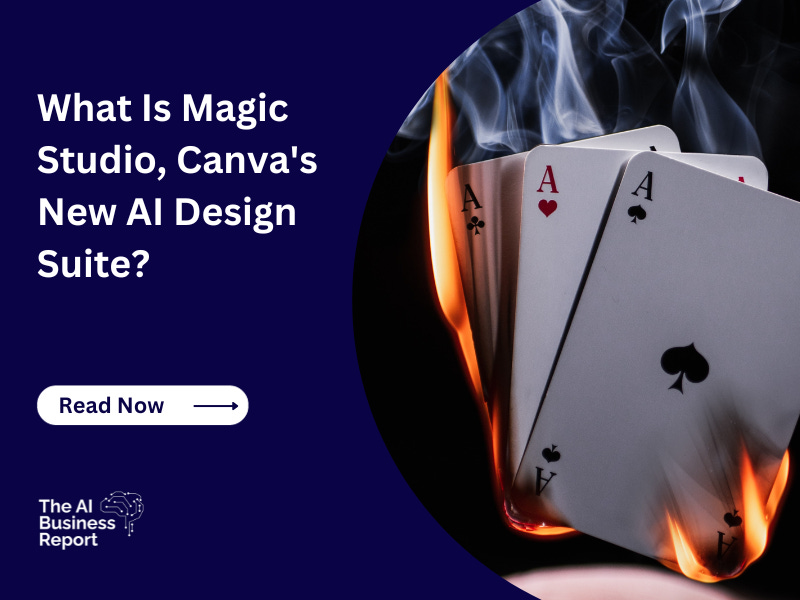What Is Magic Studio, Canva's New AI Design Suite?
Elevate Your Design With Canva’s Magic Studio
With over 135 million active users, Canva has become the graphic design platform of choice for many businesses, including 85% of the United State’s largest companies. This is thanks to Canva’s impressive suite of easy-to-use design tools that can significantly enhance a business’ branding and marketing efforts. The company, however, has recently taken its features to the next level with the release of the new AI-powered tool suite Magic Studio.
What Is Canva’s Magic Studio?
In what was already a convenient and user-friendly platform, Magic Studio further boosts Canva’s overall appeal by leveraging artificial intelligence to offer intuitive visual and text-based generation capabilities. This means that, instead of relying on stock images, users can generate original visuals that can then be copied and implemented into their own designs.
According to Canva’s website:
“Whether you’re an individual, a team, or a large organization, with Magic Studio there’s no need to toggle between multiple AI tools or learn lots of different software – all the best of AI is at your fingertips. Created for the 99% of the world without complex design skills, Magic Studio is jam-packed with easy-to-use AI-powered features across every part of Canva to help you work smarter.”
Magic Studio Features
With Magic Studio, Canva users can access a variety of powerful AI-driven features aimed at ensuring a smooth and high-quality design experience. Some of the top features offered in the tool suite include:
Magic Design for Video: This feature enables users to upload images and videos to Canva, along with a text prompt explaining the purpose of the video they’re creating. Then, Magic Studio will stitch the video and image files together with transitions and text overlays, generating compelling videos with logical storytelling. Users can also use the “Beat Sync” feature, which matches videos with chosen sounds, to design engaging videos that are perfect for social media.
Magic Design for Presentations: For presentations, Magic Design allows users to enter a text prompt at the top of the standard Canva design sidebar. Using the entered prompt, Magic Studio will generate a selection of slides tailored to the user’s requirements and story. Business branding can also be added to these slides with just a click of a button.
AI Image Editing: Magic Studio comes with several AI-powered image editing tools such as Magic Grab, which allows you to move elements within any image just like a template, and Magic Morph, which let’s users modify individual elements with new textures and designs. With these AI tools, users can easily create unique visuals comparable to those designed by a professional.
Magic Animate: Magic Animate provides the ability to instantaneously add animations and dynamic transitions to presentations using a number of styles. As a result, users won’t have to manually add animations to individual elements and slides, ensuring a quick and seamless design process.
Magic Media: Though all the above features are impressive, Magic Media stands out as a particularly useful tool, as it enables users to generate short videos from text or image prompts. This means that, if a user is creating a film storyboard in Canva, they can transform static frames into real videos in a matter of seconds.
Technology Behind Magic Studio
There’s no way for us to get behind the exact technology Canva uses, but we can make an educated guess as to the tools involved in their Magic Studio. In addition to their own data training and refinements, it’s likely that Canva has used some of the following AI technology to create Magic Studio:
Large Language Models: Large language models like GPT-3 are trained on massive text data to generate human-like responses to prompts. This natural language generation capability allows Magic Studio to generate human-like captions, headings, and paragraph text for presentations, images, and video. LLMs also help AI understand user prompts more accurately.
Artificial Neural Networks: As the core "brains" behind most AI models, neural networks can learn sophisticated patterns within training data. Multiple complex AI and machine learning techniques essentially enable the generation of visual and multimedia content.
Generative Adversarial Networks (GAN): GANs are a framework in which two neural networks contest with each other to refine generations. With this technology, highly realistic synthetic media like images, audio, and video can be produced by starting with a white noise image and refining it until the desired visuals appear.
How Magic Studio Can Elevate Your Business
Canva’s Magic Studio offers businesses, especially smaller ones that may not have access to professional designers and social media marketers, the ability to utilize a powerful and easy-to-use tool suite that’s well poised to elevate their business. Here are just a few ways Magic Studio can effectively enhance your company’s operations:
Save Time and Money: Canva Magic Studio enables users to quickly create high-quality graphics and presentations that would otherwise require expensive designers to create. This ultimately helps businesses save both time and money.
Access Professional Resources: Canva grants businesses access to professional resources, from pre-made presentation templates to stock illustrations and images. Consequently, users can easily make a professional-looking presentation without expert graphic design knowledge.
Collaborate Tools: Canva offers businesses collaborative tools such as teams and simultaneous editing, simplifying the process of creating professional presentations with colleagues.
Canva’s Magic Studio is an excellent example of the new era of artificial intelligence, where the technology’s initial hype has worn off, but has since been refined and is now being implemented into almost every digital product.
Thanks for reading.
If you enjoyed this article, please subscribe to receive email notifications whenever we post.
AI Business Report is brought to you by Californian development agency, Idea Maker.
Source

